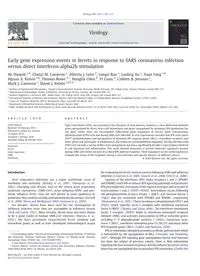
2011 Early gene expression events in ferrets in response to SARS coronavirus infection versus direct interferon-alpha2b PDF
Preview 2011 Early gene expression events in ferrets in response to SARS coronavirus infection versus direct interferon-alpha2b
Early gene expression events in ferrets in response to SARS coronavirus infection versus direct interferon-alpha2b stimulation Ali Danesh a,b, Cheryl M. Cameron a, Alberto J. León d, Longsi Ran a, Luoling Xu a, Yuan Fang a,b, Alyson A. Kelvin c,g, Thomas Rowe a,1, Honglin Chen d, Yi Guan d, Colleen B. Jonsson e, Mark J. Cameron a, David J. Kelvin a,d,f,⁎ a Division of Experimental Therapeutics, Toronto General Research Institute, University Health Network, 101 College Street, Toronto, Ontario, Canada M5G 1L7 b Department of Immunology, Faculty of Medicine, University of Toronto, Toronto, ON, Canada M5G 1L7 c Immune Diagnostics & Research, IDR , MaRS Centre, 101 College Street, Suite 200, Toronto, ON, Canada M5G 1L7 d International Institute of Infection and Immunity, Shantou University Medical College, 22 Xinling Road, Shantou, Guangdong Province, 515031, China e Center for Predictive Medicine, 950 N. Hurstbourne Pkwy, Louisville, KY 40222, USA f Department of Biomedical Sciences, University of Sassari, Sassari, Italy g SaRD, Sardinia Research and Development srl, Porto Conte Ricerche Research Centre, S.P. 55 Porto Conte Capo Caccia km 8,400, Loc. Tramariglio, 07041, Alghero (SS), Italy a b s t r a c t a r t i c l e i n f o Article history: Received 25 February 2010 Returned to author for revision 23 August 2010 Accepted 1 October 2010 Available online 28 October 2010 Keywords: Ferret Gene expression SARS Interferon Type I interferons (IFNs) are essential to the clearance of viral diseases, however, a clear distinction between genes upregulated by direct virus–cell interactions and genes upregulated by secondary IFN production has not been made. Here, we investigated differential gene regulation in ferrets upon subcutaneous administration of IFN-α2b and during SARS-CoV infection. In vivo experiments revealed that IFN-α2b causes STAT1 phosphorylation and upregulation of abundant IFN response genes (IRGs), chemokine receptors, and other genes that participate in phagocytosis and leukocyte transendothelial migration. During infection with SARS-CoV not only a variety of IRGs were upregulated, but also a significantly broader range of genes involved in cell migration and inflammation. This work allowed dissection of several molecular signatures present during SARS-CoV which are part of a robust IFN antiviral response. These signatures can be useful markers to evaluate the status of IFN responses during a viral infection and specific features of different viruses. © 2010 Elsevier Inc. All rights reserved. Introduction Viral respiratory infections are a major worldwide cause of morbidity and mortality (Kolling et al., 2001; Thompson et al., 2003). Emerging viral threats, such as the severe acute respiratory syndrome coronavirus (SARS-CoV), avian influenza H5N1 and pan- demic influenza H1N1 virus are well poised to cause epidemics or pandemics that could be socially and economically disastrous (Dushoff et al., 2006; Weiss and McMichael, 2004; Dawood et al., 2009). For decades, ferrets have been used for the investigation of influenza infection since they are susceptible to influenza viruses (Hull and Loosli, 1951). More recently, ferrets have also been shown to be a good model of human SARS-CoV infection (Martina et al., 2003). We have previously characterized ferret cytokine and chemokine genes as well as have developed immunological assays for evaluating the ferret immune system following SARS and influenza infection (Cameron et al., 2008; Danesh et al., 2008; Ochi et al., 2008). Ligation of the interferon (IFN) alpha receptors 1 and 2 (IFNAR1 and IFNAR2) with IFN-α induces IFN signaling pathways and promotes IFN gene induction. Formation of the signal transducer and activator of transcriptions 1 and 2 (STAT1–STAT2) heterodimer occurs following the phosphorylation of Janus kinase 1 (JAK1) and tyrosine kinase 2 (Tyk2) that are associated with IFNAR2 and IFNAR1, respectively (Marijanovic et al., 2007). These two kinases phosphorylate STAT1 and STAT2, which together form a complex with interferon regulatory factor 9 (IRF9) (Takaoka and Yanai, 2006). The interferon stimulatory factor 3 complex (ISGF3) binds to interferon-stimulated response element (ISRE) and activates transcription of IFN-α inducible genes, including 2'–5' oligoadenylate synthase 1 (OAS1), myxovirus resis- tance 1 (MX1), interferon stimulated gene 15 (ISG15) and many other IFN-response genes (IRGs) (Uddin and Platanias, 2004). IFN-α stimulation ultimately promotes a cellular antiviral state which is hallmarked by the upregulation of IRGs (Chevaliez and Pawlotsky, 2007). Although IFN signaling gene upregulation during viral infection has been the subject of previous reports, there is little information regarding the host immune responses directly induced by viruses versus those that are upregulated due to secondary IFN stimulation (Chelbi-Alix Virology 409 (2011) 102–112 ⁎ Corresponding author. Division of Immunology, International Institute of Infection and Immunity, Shantou University Medical College, 22 Xinling Road, Shantou, Guangdong, China, 515041. Fax: +86 754 88573991. E-mail address:
